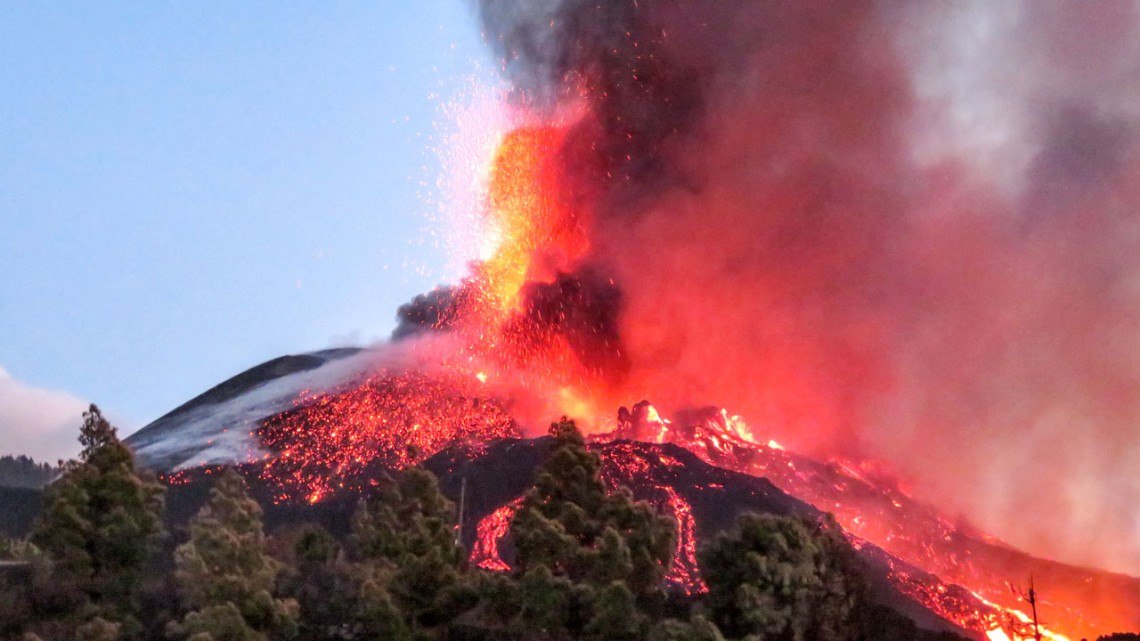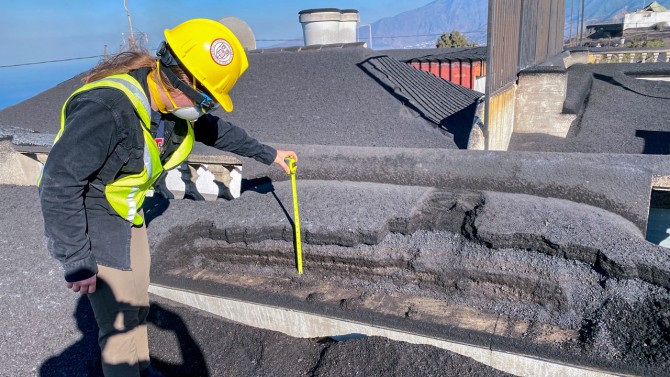
The active, fiery Cumbre Vieja volcano has been erupting since Sept. 19.
Cornell scientists coolly recall fiery volcano visit
By Blaine Friedlander
Far above the populated towns on La Palma in Spain’s Canary Islands, off the coast of western Africa, Esteban Gazel and Kyle Dayton carried equipment from their car and hiked toward the erupting Cumbre Vieja volcano’s active vents.
Gazel, an associate professor in the Department of Earth and Atmospheric Sciences in the College of Engineering, and Dayton, a doctoral student, had joined a small, elite team of international researchers – few of whom were from the United States – in late October to study components of the air near an active volcano.
“No one is allowed to go within a kilometer of the vent because it is very dangerous,” said Dayton, who is studying volcanism in the Canary Islands for her dissertation. This trip was her first time seeing a volcano. “We could see the side profile of the volcano and there were four active vents.
“When you think of volcanoes, they’re usually dead,” she said. “Just seeing how this one changed from day to day was probably the biggest shocker. Lava flows were completely visible on the surface one day and had channelized underground and were no longer visible the next.
“We got to see giant blocks falling into the volcano and watched as the volcano changed shape,” she said. “It was incredibly dynamic.”
The new vents in the Cumbre Vieja volcano on La Palma began erupting Sept. 19, after about five decades of dormancy. Gazel – a faculty fellow at the Cornell Atkinson Center for Sustainability, and at Cornell’s Carl Sagan Institute – was invited by research organizers Francisco José Pérez Torrado and Juan Carlos Carracedo, professors at the University of Las Palmas de Gran Canaria and by Valentin Troll, chair of petrology, Uppsala University, Sweden, to join their team.
At La Palma, Dayton and Gazel collected on-site micro and nano samples of the air as part of a NASA-funded project to investigate the global effects of volcanic ash on the Earth systems in collaboration with department faculty members Natalie Mahowald, the Irving Porter Church Professor of Engineering; and Matthew Pritchard, professor of earth and atmospheric sciences.
Seeing is believing, but to study nanoparticles from a volcano, you must follow your nose. “Volcanic gases contain sulfur, so if you catch a whiff of sulfur, that’s the time to collect a sample from the volcanic plume,” Dayton said. “We drove around La Palma over several days with the car windows open, asking ‘Do you smell anything?’”
Gazel explained that the scientists wore gas masks and other mask types to protect against volcanic particulates close to the vent, but they hunted for particles transported far enough away so that the volcanic gases were no longer a hazard.
The watched the fiery fountains – always from a safe distance – purge magma from the Earth both day and night. Their sampling equipment sniffed the air and scooped tephra, loose volcanic material.
In a preliminary show and tell, after returning from the trip, Gazel showed the microscopic samples – mineral “skeletal” in shape, which cooled faster than the time needed to build a complete structure – collected from the surrounding air.
This preliminary evidence suggests that the melt-transport system from the mantle to the vent is quite fast. They are pointy, glass volcanic dust with nano crystals reminiscent of snowflakes. “You can see how pointed things are,” he said, noting the need for particulate masks. “Without masks, you can breathe this in and because of their size, they could go deep into your lungs.”
On one day, Gazel and Dayton collected samples from San Nicolás on the southern part of La Palma, where the town plaza was full of tephra. The residents had not cleaned the benches of the volcanic soot. “We were so lucky that they did not clean the benches of the plaza,” Gazel said, because that left several layers of the different eruptions to sample up to that day, the record of the eruption.
Aside from sight and smell, another sense the scientists used was feeling:
Dayton has a smart phone app that indicates volcanic earthquakes anywhere in the world and her distance from the epicenter. “While we were there, we felt a bunch of earthquakes,” she said. “One night, I woke up four or five times from feeling earthquakes. You can almost feel that supply of magma affecting the surface.
“Then you realize from the phone app,” Dayton said, “that these earthquakes are 35 to 40 kilometers below us.”
Media Contact
Get Cornell news delivered right to your inbox.
Subscribe

